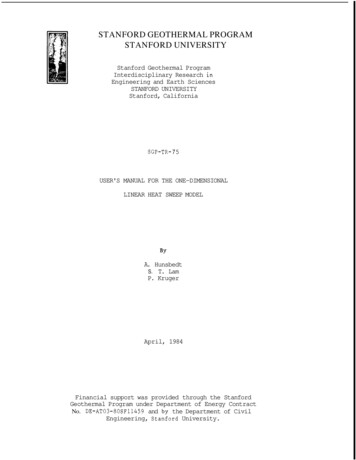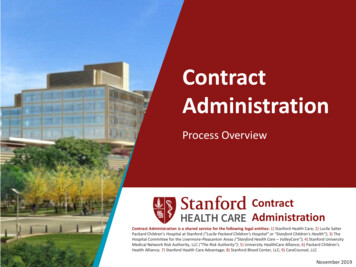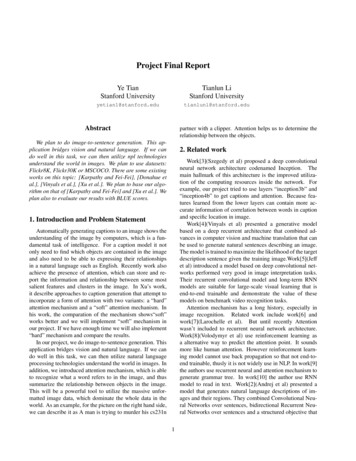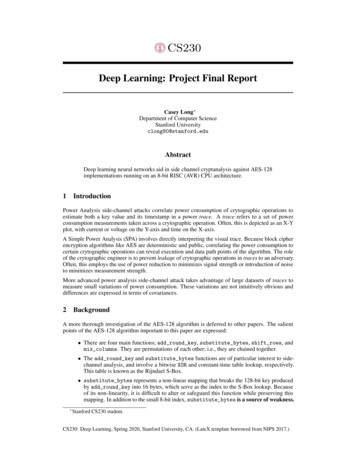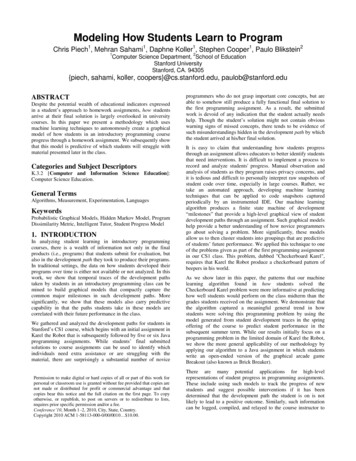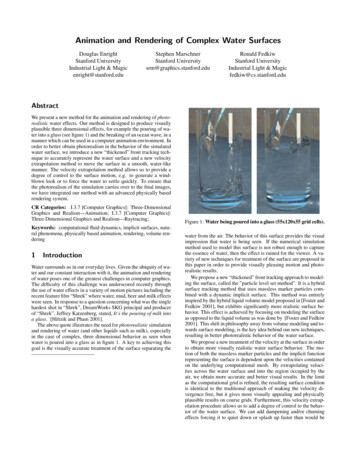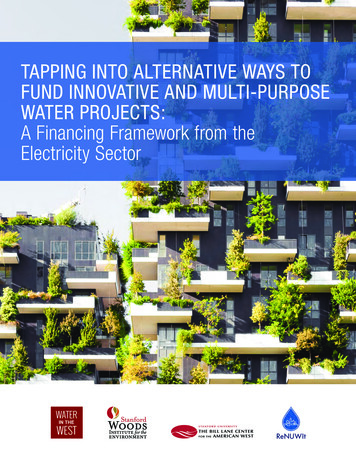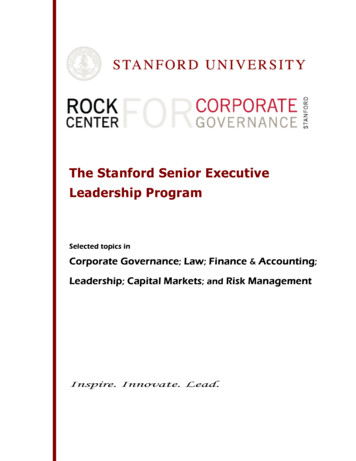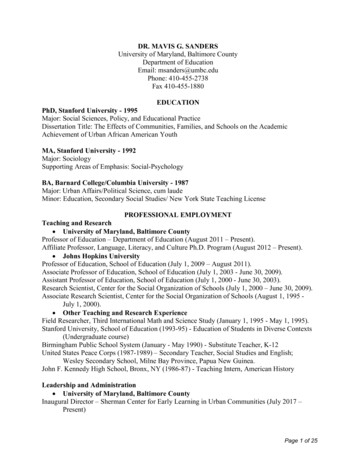
Transcription
DR. MAVIS G. SANDERSUniversity of Maryland, Baltimore CountyDepartment of EducationEmail: msanders@umbc.eduPhone: 410-455-2738Fax 410-455-1880EDUCATIONPhD, Stanford University - 1995Major: Social Sciences, Policy, and Educational PracticeDissertation Title: The Effects of Communities, Families, and Schools on the AcademicAchievement of Urban African American YouthMA, Stanford University - 1992Major: SociologySupporting Areas of Emphasis: Social-PsychologyBA, Barnard College/Columbia University - 1987Major: Urban Affairs/Political Science, cum laudeMinor: Education, Secondary Social Studies/ New York State Teaching LicensePROFESSIONAL EMPLOYMENTTeaching and Research University of Maryland, Baltimore CountyProfessor of Education – Department of Education (August 2011 – Present).Affiliate Professor, Language, Literacy, and Culture Ph.D. Program (August 2012 – Present). Johns Hopkins UniversityProfessor of Education, School of Education (July 1, 2009 – August 2011).Associate Professor of Education, School of Education (July 1, 2003 - June 30, 2009).Assistant Professor of Education, School of Education (July 1, 2000 - June 30, 2003).Research Scientist, Center for the Social Organization of Schools (July 1, 2000 – June 30, 2009).Associate Research Scientist, Center for the Social Organization of Schools (August 1, 1995 July 1, 2000). Other Teaching and Research ExperienceField Researcher, Third International Math and Science Study (January 1, 1995 - May 1, 1995).Stanford University, School of Education (1993-95) - Education of Students in Diverse Contexts(Undergraduate course)Birmingham Public School System (January - May 1990) - Substitute Teacher, K-12United States Peace Corps (1987-1989) – Secondary Teacher, Social Studies and English;Wesley Secondary School, Milne Bay Province, Papua New Guinea.John F. Kennedy High School, Bronx, NY (1986-87) - Teaching Intern, American HistoryLeadership and Administration University of Maryland, Baltimore CountyInaugural Director – Sherman Center for Early Learning in Urban Communities (July 2017 –Present)Page 1 of 25
Associate Chair – Department of Education (July 2014 – July 2016). Johns Hopkins UniversityFounding Director, Leadership for School, Family, and Community Collaboration graduatecertificate program (August 2003 – July 2011)Assistant Director, National Network of Partnership Schools (August 1, 1995 - July 1, 2000). Other Leadership and Administrative ExperienceDepartment Chair, Social Studies, Wesley Secondary School, Milne Bay Province, Papua NewGuinea. (United States Peace Corps, 1988-1989).COURSES AND SUPERVISIONUniversity of Baltimore, Department of Education (2011 – Present)Courses TaughtAFST440/LLC750Educational Policy and the African American CommunitySTEM533Culturally Responsive Instruction in STEMEDUC785Advanced Instructional Leadership PracticumEDUC781Teacher LeadershipEDUC650Education in Cultural PerspectiveEDUC795Seminar in the Study of TeachingEDUC771Research Designs in EducationEDUC792Capstone SeminarLLC 898Pre-candidacy Doctoral ResearchLLC 899Doctoral Dissertation ResearchSupervising/MentoringUMBC Faculty Liaison for Violetville Professional Development School, Baltimore, Maryland(2012 – 2016)Secondary Social Studies Supervisor, Violetville Elementary/Middle School (2012 – 2016)The Johns Hopkins University, School of Education (2000-2011)Courses TaughtED 851.630, School, Family, and Community Collaboration for School Improvement IED 851.631, School, Family, and Community Collaboration for School Improvement IIED 881.611, Action Research for School ImprovementED 882.524, Education of Culturally Diverse StudentsED 883.711, Qualitative Research Methodology IED 883.712, Qualitative Research Methodology IIED 855.801, Doctoral Seminar in Educational LeadershipED 855.802, Doctoral Seminar in CollaborationDirected Student Learning – 19 Doctoral StudentsDissertation Committee Member, School of Social Work, University of Maryland (September2016 – Present).Advised: Dante DeTablanDissertation Committee Chair, School of Public Policy, University of Maryland, BaltimoreCounty (January 2018 – July 2019)Page 2 of 25
Advised: Anthony LaneDissertation Committee Member, Psychology Department, University of Maryland, BaltimoreCounty (September 2017 – June 2019)Advised: Cassandra SimonsDissertation Committee Co-Chair, Language, Literacy, and Culture, University of Maryland,Baltimore County, (April 2015 – June 2019).Advised: Shawntay StocksComprehensive Examination, First Reader, Language, Literacy, and Culture, University ofMaryland, Baltimore County. (June, 2014 – December 2015).Advised: Shawntay StocksDissertation Committee Member, School of Education, Johns Hopkins University. (April 2017 –September 2018).Advised: Rabiah KhalilDissertation Committee Chair, Language, Literacy, and Culture, University of Maryland,Baltimore County. (February 2013 – April 2015).Advised: Uzma RashidDissertation Committee Member, Psychology Department, University of Maryland, BaltimoreCounty. (October 1, 2009 – July 2014).Advised: Maria Finger-ElamDissertation Committee Member – School of Public Policy, University of Maryland, BaltimoreCounty. (September 2012 – April 2014).Advised: Kevin HamlinComprehensive Examination, First Reader, Language, Literacy, and Culture, University ofMaryland, Baltimore County. (November, 2012 – February 2013).Advised: Uzma RashidDissertation Committee Member – Language, Literacy, and Culture, University of Maryland,Baltimore County. (2013).Advised: Beshon SmithDissertation Committee Member, ED Teacher Development/Leadership, Johns HopkinsUniversity. (2012).Advised: William MatsuzakiDepartmental Oral Examination Committee Member, ED Teacher Development/Leadership,Johns Hopkins University. (2010).Advised: David ClappDissertation Committee Chair, ED Teacher Development/Leadership, Johns Hopkins University.(2009).Advised: Tiffany Wright, Award: Phi Delta Kappan Dissertation AwardDissertation Committee Chair, ED Teacher Development/Leadership, Johns Hopkins University.(2008).Advised: Robin Saunders, Award: Lumina Fellowship AwardDissertation Committee Chair, ED Teacher Development/Leadership, Johns Hopkins University.(2008).Advised: Yolanda Abel, Award: MASCD Mary Ruchkin Research AwardDissertation Committee Chair, ED Teacher Development/Leadership, Johns Hopkins University.(2007).Advised: Tamitha Campbell, Award: MASCD Mary Ruchkin Research AwardPage 3 of 25
Dissertation Committee Chair, ED Teacher Development/Leadership, Johns Hopkins University.(2005).Advised: Gilda MartinezDissertation Defense Committee Member, Psychology Department, University of Maryland,Baltimore County. (2004).Advised: Linda GorhamDissertation Committee Member, Educational Psychology, Howard University. (1999).Advised: Henry JacksonPUBLICATIONSBooks (5)Sanders, M. & Galindo, C. (Eds.) (In press, spring 2020). Reviewing the Success of Full-ServiceCommunity Schools in the US: Challenges and Opportunities for Students, Teachers, andCommunities. London, UK: Routledge.Epstein, J. L., Sanders, M., Sheldon, S., Simon, B., Salinas, K., Jansorn, N., Van Voorhis, F.,Martin, C., Thomas, B., Greenfeld, M., Hutchins, D., Williams, K. (2018). School, familyand community partnerships: Your handbook for action. (4th ed.). Thousand Oaks, CA:Corwin Press.Epstein, J. L., Sanders, M., Sheldon, S., Simon, B., Salinas, K., Jansorn, N., Van Voorhis,F., Martin, C., Thomas, B., Greenfeld, M., Hutchins, D., Williams, K. (2009). School,family and community partnerships: Your handbook for action. (3rd ed.). ThousandOaks, CA: Corwin Press.Epstein, J. L., Sanders, M., Salinas, K., Simon, B., Van Voorhis, F., Jansorn, N. (2002).School, family and community partnerships: Your handbook for action. (2nd ed.).Thousand Oaks, CA: Corwin Press.Epstein, J. L., Coates, L., Salinas, K., Sanders, M., Simon, B. (1997). School, family andcommunity partnerships: Your handbook for action. (1st ed.). Thousand Oaks, CA:Corwin Press.Sanders, M., Sheldon, S. (2009). Principals matter: A guide to comprehensive programs ofschool, family, and community partnerships. Thousand Oaks, CA: Corwin Press.Reviewed by: Lewis, W. D. (2010). A review of Principals Matter: A guide to school,family, and community partnerships. Journal of School Public Relations, 31(1), 173-175.Sanders, M. (2006). Building school-community partnerships: Collaboration for student success.Thousand Oaks, CA: Corwin Press.Reviewed by: Hong, Soo (2006). Editor's Review - Building School-CommunityPartnerships. Harvard Educational Review, Summer Issue.Reviewed by: Estep, Karen (2007). Focusing on the Community in School CommunityPartnerships: A Book Review The School Community Journal, 17, 2.Reviewed by: Forsyth, S. (2014). A Review of Building School-CommunityPartnerships: Collaboration for Student Success. Region 16 Education Service Center.Page 4 of 25
Sanders, M. (Ed.) (2000). Schooling students placed at risk: Research, policy, and practice in theeducation of poor and minority adolescents. Mahwah, NJ: Lawrence Erlbaum Associates.Reviewed by: Angelle, P. (2009). Book Review of Schooling Students Placed At Risk.Journal of Education for Students Placed at Risk (JESPAR), 8, 2.Book Chapters (21 published or in press) (*Indicates publications with current and formerstudents)Sanders, M. & Galindo, C. (in press, spring 2020). The Role of Teachers in Transforming anUrban Full-Service Community High School: Exploring Processes of Change. In M.Sanders and C. Galindo (Eds). Reviewing the Success of Full-Service Community Schoolsin the US: Challenges and Opportunities for Students, Teachers, and Communities.London, UK: Routledge.Galindo, C. & Sanders, M. (2019). Achieving equity in education through full-servicecommunity schools. In S. Sheldon and T. Turner-Vorbeck (Eds). Handbook of Family,School, Community Partnerships in Education (pp. 511-530). Malden, MA: Wiley.*Sanders, M., Watkins-Lewis, K., & Cochrane, K. (2017). The Role of Out-of-School TimePrograms in Bridging the Diversity Gap and Improving Educational Opportunities forAfrican American Students. In H. Malone and T. Donohue (Eds.). The Growing Out-ofSchool Time Field: Past, Present, and Future (pp. 71-86). Charlotte, North Carolina:Information Age Publishing.Sanders, M. & Galindo, C. (2014). Communities, Schools, and Teachers. In K. Bauserman, L.Martin, S. Kragler, & D. Quatroche (Eds.) Handbook of Professional Development inEducation: Successful Models and Practices, PreK-12 (pp. 103-124). New York, NY:Guilford Publishing.Sanders, M. (2013). Poverty, Families, and Schools. In C. Yeakey, V. Thompson, & A. Wells(Eds.). Urban Ills: Confronting Twenty First Century Dilemmas of Urban Living inGlobal Contexts (pp. 329-350). Lanham, MD: Lexington Books.*Sanders, M. & Hembrick-Roberts, J. (2013). Leadership for Service Integration in Schools. InL. Tillman and J. Scheurich (Eds.), Handbook of Research on Educational Leadership forDiversity and Equity (pp. 476-493). London, United Kingdom: Routledge/Taylor andFrancis.*Sanders, M., Martinez, G., White, M. (2012). Reaching Out: Partnering with the Families andCommunities of African American Urban Youth. In J. Moore III & L. Chance (Ed.),Urban school contexts for African American students: Crisis and prospects forImprovement (pp. 245-269). New York, NY: Peter Lang.Sanders, M. (2011). Community Involvement in Middle Schools: Partnering for YoungAdolescents’ Success. In C. Weiland (Ed.). This We Believe in Action: ImplementingPage 5 of 25
Successful Middle Schools. Westerville, OH: National Middle School AssociationSanders, M. (2011). Family Engagement in High School. In S. Redding, M. Murphy, & P.Sheley. Handbook on Family and Community Engagement. (pp. 141-146). Washington,DC. Department of Education.Sanders, M. (2010). Parents as Leaders: School, Family, and Community Partnerships in TwoDistricts. In D. Houston, A. Blankstein, and R. Cole (Ed.), Leadership for Family andCommunity Involvement. (pp.13-32). Thousand Oaks, CA: Corwin Press.Sanders, M. (2009). District Leadership and School-Community Collaboration. In A. Honigsfeld& A. Cohan (Ed.), Breaking the Mold of School Instruction and Organization: Innovativeand Successful Practices for the 21st Century. (pp. 139-147). Lanham, MD: Rowman &Littlefield.Sanders, M. (2009). Teachers and Parents. In L. Saha & A. Dworkin (Ed.), The NewInternational Handbook of Teachers and Teaching. (pp. 331-343). New York, NY:Springer.*Sanders, M., Campbell, T. (2007). Securing the ties that bind: Community involvement and theeducational success of African-American children and adolescents. In J. Jackson (Ed.),Strengthening the Educational Pipeline for African Americans: Informing Policy andPractice. (pp. 141-164). Buffalo, NY: State University of New York (SUNY) Press.Epstein, J., Sanders, M. (2002). Family, school, and community partnerships. In M. Bornstein(Ed.), Handbook of parenting, Volume 5: Practical issues in parenting. (2nd ed., pp. 407438). Mahwah, NJ: Lawrence Earlbaum Associates.*Sanders, M., Jones, G., Abel, Y. (2002). Involving families and communities in the educationof children and youth placed at-risk. In S. Stringfield & D. Land (Ed.), Educating at riskstudents. (pp. 171-188). Chicago, IL: National Society for the Study of Education.Sanders, M. (2001). School-community partnerships and faith-based organizations. In E.J.Dionne & M.H. Chen (Ed.), Sacred places, civic purposes: Should government helpfaith-based charity?. (pp. 161-175). Washington, DC: The Brookings Institution.Sanders, M., Epstein, J. (2000). Building school, family, and community partnerships insecondary schools. In M. Sanders (Ed.), Schooling students placed at risk: Research,policy, and practice in the education of poor and minority adolescents. (pp. 339-362).Mahwah, NJ: Lawrence Erlbaum Associates.Epstein, J., Sanders, M. (2000). Connecting home, school, and community: New directions forsocial research. In M. Hallinan (Ed.), Handbook of sociology of education. (pp. 285-306).New York, NY: Plenum.Page 6 of 25
Sanders, M., Herting, J. (2000). Gender and the effects of school, family, and church support onthe academic achievement of African-American urban adolescents. In M. Sanders (Ed.),Schooling students placed at risk: Research, policy, and practice in the education ofpoor and minority adolescents. (pp. 141-162). Mahwah, NJ: Lawrence ErlbaumAssociates.Sanders, M., Jordan, W. (2000). Teacher-student relations and academic achievement in highschool. In M. Sanders (Ed.), Schooling students placed at risk: Research, policy, andpractice in the education of poor and minority adolescents. (pp. 65-82). Mahwah, NJ:Lawrence Erlbaum Associates.Sanders, M., Epstein, J. (1998). School-family-community partnerships and educational change:International perspectives. In A. Hargreaves, A. Lieberman, M. Fullan, & D. Hopkins(Ed.), International handbook of educational change. (pp. 482-502). Hingham, MA:Kluwer Academic Publishers.Refereed Encyclopedia Articles (4)Sanders, M. (2017). Community-School Partnerships. In Peppler, K (Ed.), Encyclopedia for Outof-School Learning. Thousand Oaks, CA: Sage Publications (pp. 112-114). Tablan, D. & Sanders, M. (2017) Community Outreach. In Peppler, K (Ed.), Encyclopediafor Out-of-School Learning (p. 105). Thousand Oaks, CA: Sage Publications. ders, M. (2012). African American Families and Education. In J. Banks (Ed.), Encyclopediaof Diversity in Education. Thousand Oaks, CA: Sage Publications.Sanders, M. (2012). Community-School Partnerships. In J. Banks (Ed.), Encyclopedia ofDiversity in Education. Thousand Oaks, CA: Sage Publications.Refereed Journal Articles (31 published or in press)Galindo, C. & Sanders, M. (under review). Teachers’ Academic Optimism in an Urban FullService Community High School. American Journal of Education.Sanders, M., Galindo, C., & DeTablan, D. (2019). Leadership for Collaboration: Exploring HowCommunity School Coordinators Advance the Goals of Full-Service CommunitySchools. Children and Schools, cdz006, https://doi.org/10.1093/cs/cdz006.Sanders, M., Galindo, C., & Allen, K. M. (2018). Professional Capital and Responses to StudentDiversity: A Qualitative Exploration of the Role of Teachers in Full-Service CommunitySchools. Urban Education, 0042085918770719.Sanders, M. G. (2018). Crossing Boundaries: A Qualitative Exploration of Relational Leadershipin Three Full-Service Community Schools. Teachers College Record, 120(4), n4, 1-36.Page 7 of 25
Sanders, M., Galindo, C., Vega-Marquis, L. & Milloy, C. (2017). Marguerite Casey Foundation:Reflecting on Fifteen Years of Philanthropic Leadership through a SummativeEvaluation. The Foundation Review, 9(2), 36-52.Galindo, C., Sanders, M., & Abel, Y. (2017). Transforming Educational Experiences in LowIncome Communities: A Qualitative Case Study of Social Capital in a Full-ServiceCommunity School. American Educational Research Journal, Centennial Edition,54(1S), 140-163.Hrabowski, F. & Sanders, M. (2015, Winter). Strengthening Diversity in the Teaching Force:One University’s Perspective. Thought & Action (The NEA Higher Education Journal),32, 101-116.Sanders, M. (2015). Leadership, Partnerships, and Organizational Development: ExploringComponents of Effectiveness in Three Full-service Community Schools. SchoolEffectiveness and School Improvement, 27(2), 1-21.Sanders, M. (2014). Principal Leadership for School, Family, and Community Partnerships: TheRole of a Systems Approach to Reform Implementation. American Journal ofEducation, 120(2), 233-255.Sanders, M. (2012).Sustaining Programs of School, Family, and Community Partnerships: AQualitative Longitudinal Study of Two Districts. Educational Policy. 26(6), 845–869.Sanders, M. (2012). Achieving Scale at the District Level: A Longitudinal Multiple Case Studyof a Partnership Reform. Educational Administration Quarterly, 48(1), 154-86.Sanders, M. (2009). Collaborating for Change: How an Urban School District and a CommunityBased Organization Support and Sustain School, Family, and Community Partnerships.Teachers College Record, 111(7), 1693-1712.Sanders, M. (2008). How Parent Liaisons Can Help Bridge Home and School. Journal ofEducational Research, 101(5), 287-297.Sanders, M. (2008). Using diverse data to develop and sustain school, family, and communitypartnerships: A district case study. Education Management, Administration, andLeadership, 36(4), 530-545.Sanders, M. (2006). Missteps in team leadership: The experiences of six novice teachers in threeurban schools. Urban Education, 41(3), 277-304.Epstein, J. L., Sanders, M. (2006). Preparing educators for school-family-communitypartnerships: Results of a national survey of colleges and universities. Peabody Journalof Education, 81(2), 81-120.Page 8 of 25
Sanders, M., Lewis, K. (2005). Building bridges toward excellence: Community involvement inhigh schools. High School Journal, 88(3), 1-9.Sanders, M., Epstein, J. L., Sheldon, S. (2005). Improving schools’ partnership programs in theNational Network of Partnership Schools. Journal of Educational Research and PolicyStudies, 5(1), 24-47.Sanders, M. (2003). Community involvement in schools: From concept to practice. Educationand Urban Society, 35(2), 161-181.*Sanders, M., Simon, B. (2002). A Comparison of program development at elementary, middle,and high schools in the National Network of Partnership Schools. The School CommunityJournal, 12(1), 7-27.*Sanders, M., Harvey, A. (2002). Beyond the school walls: A case study of principal leadershipfor school-community collaboration. Teachers College Record, 104(7), 1345-1368.Sanders, M. (2001). A study of the role of “community” in comprehensive school, family, andcommunity partnership programs. The Elementary School Journal, 102(1), 19-34.Sanders, M. (2001). Schools, families, and communities partnering for middle level students’success. NASSP Bulletin, 85(627), 53-61.Sanders, M. (2000). Creating successful school-based partnership programs with families ofspecial needs students. The School Community Journal, 10(2), 37-56.Sanders, M., Epstein, J. L. (2000). The National Network of Partnership Schools: How researchinfluences educational practice. Journal of Education for Students Placed At Risk, 5(1 &2), 61-76.Sanders, M. (1999). Improving school, family and community partnerships in urban middleschools. Middle School Journal, 31(2), 35-41.Sanders, M. (1999). Schools’ programs and progress in the National Network of PartnershipSchools. The Journal of Educational Research, 92(4), 220-229.Sanders, M. (1998). The effects of school, family and community support on the academicachievement of African-American adolescents. Urban Education, 33(3), 385-409.Sanders, M. (1997). Overcoming obstacles: Academic achievement as a response to racism anddiscrimination. Journal of Negro Education, 66(1), 83-93.Sanders, M. (1996). Action teams in action in the Baltimore School-Family-CommunityPartnership Program. Journal of Education for Students Placed At Risk, 1(3), 249-262.Page 9 of 25
Sanders, M. (1996). School-family-community partnerships focused on school safety. Journal ofNegro Education, 65(3), 369-374.Non-Refereed and Invited Journal Articles (11)Sanders, M. & Galindo, C. (2019). Introduction: Research for a New Era of Full-ServiceCommunity Schools, Journal of Education for Students Placed at Risk (JESPAR: SpecialIssue on Full-Service Community Schools – Guest Editors: Mavis Sanders and ClaudiaGalindo), 24(3), 193-196. do, C. & Sanders, M. (2019). Final Thoughts: Working Towards the Sustainability of FullService Community Schools. Journal of Education for Students Placed at Risk (JESPAR:Special Issue on Full-Service Community Schools – Guest Editors: Mavis Sanders andClaudia Galindo), 24(3), 314-319. rs, M. (2014). Why Are School, Family, and Community Partnerships Important forStudents with Disabilities? The Special Edge, California State Department of Education.Sanders, M. (January 2014). Getting Accountability Right within a Systems Approach to SchoolReform. AJE Forum: Forum of the American Journal of Education,http://www.ajeforum.com/?p 644Sanders, M. (2008). School-Community Partnerships: Hope for 21st Century Schools. NationalAssociation of Elementary School Principals (NAESP) Leadership Compass, 6(2), 1-3.Sanders, M. (2008). Supporting family engagement through district-level partnerships. HarvardEvaluation Exchange, 14(1 & 2), 11 & 38.Sanders, M. (2007). Transcending Boundaries. Principal Leadership, 8(2), 38-42.Sanders, M., Lewis, K. (2004). Partnerships at an urban high school: Meeting the parentinvolvement requirements of No Child Left Behind. E-Journal of Teaching and Learningin Diverse Settings, 2(1), 1-21.Sanders, M. (1998). School-family-community partnerships: An action team approach. The HighSchool Magazine, 5(3), 38-49.Sanders, M., Epstein, J. (1998). International perspectives on school, family and communitypartnerships. Childhood Education, 74(6), 340-342.Sanders, M. (1996). Building family partnerships that last. Educational Leadership, 54(3), 61-66.Book Reviews and Editorials (7)Sanders, M. (2011). Book Review: Better Together: A Model University-CommunityPartnership for Urban Youth. Teachers College Record.Page 10 of 25
Sanders, M. (2010). Book Review: Community Organizing for Stronger Schools: Strategies andSuccesses. Teachers College Record.Sanders, M. (2010). Book Review: (Mis)Understanding Families: Learning from Real Familiesin Our Schools. Teachers College Record.Sanders, M. (2007). Book Review: Diverse Partnerships for Student Success: Strategies andTools to Help School Leaders. Teachers College Record.Sanders, M. (2001). Book Review: All together now: Creating middle class schools throughpublic school choice. (vol. 104, pp. 1002-1005). Teachers College Record.Sanders, M. (2000). Editorial: Will Baltimore Sustain Its Leadership On School, Family, andCommunity Partnerships?. Baltimore Sun.Sanders, M. (1997). Book Review: Silver rights. (vol. 2, pp. 85-87). Journal of Education forStudents Placed at Risk.Reports (9)Sanders, M. & Galindo, C. (2016). Fifteen Years of Philanthropic Leadership: A SummativeEvaluation of the Marguerite Casey Foundation. Seattle, WA: Marguerite CaseyFoundation.Sanders, M., Simon, B. (2002). A comparison of school, family, and community partnershipprograms in elementary, middle, and high schools. Baltimore, MD: Center for Researchon the Education of Students Placed At Risk, Johns Hopkins University.Mitchell, A., Sanders, M. (2001). Vouchers and equal educational opportunity for minority andlow-income students. Washington, DC: National Alliance of Black School Educators.Sanders, M. (2000). Schools, families, and communities – Partnership for student success.Reston, VA: National Association of Secondary School Principals.Sanders, M., Epstein, J., Connors, L. (1999). Family partnerships with high schools: Theparents’ perspective. Baltimore, MD: Center for Research on the Education of StudentsPlaced At Risk, Johns Hopkins University.Epstein, J., Sanders, M., Clark, L. (1999). Preparing educators for school-family-communitypartnerships: Results of a national survey of colleges and universities. Baltimore, MD:Center for Research on the Education of Students Placed At Risk, Johns HopkinsUniversity.Sanders, M. (1997). Building effective school-family-community partnerships in a large urbanschool district. Baltimore, MD: Center for Research on the Education of Students PlacedAt Risk, Johns Hopkins University.Page 11 of 25
Sanders, M. (1996). Benchmarks for excellence: School-family-community partnerships.Washington, DC: Blue Ribbon Schools Program, US Department of Education.Sanders, M. (1996). School-family-community partnerships and the academic achievement ofAfrican American urban adolescents. Baltimore, MD: Center for Research on theEducation of Students Placed At Risk, Johns Hopkins University.PRESENTATIONSNational Refereed Conference Presentations (44)Sanders, M., & Galindo, C. “The Transformative Potential of Full-Service Community Schools:Exploring Processes of Change in an Urban High School.” American EducationalResearch Association, Toronto, Ontario, Canada. (April 2019).Sanders, M., & Watkins-Lewis, K. “Out-of-School Time Programs and the Teacher DiversityGap: Examining CDF Freedom Schools as an Exemplar.” American EducationalResearch Association, New York, NY. (April 2018).Galindo, C. & Sanders, M. “Achieving Equity in Education Through Full-Service CommunitySchools.” American Educational Research Association, New York, NY. (April 2018).Galindo, C., & Sanders, M. “Exploring the Role of Teachers: Academic Optimism in an UrbanFull-Service Community High School.” American Educational Research Association,New York, NY. (April 2018).Sanders, M., Galindo, C., & DeTablan, D. “Bridging the Community and School: Exploring theRole(s) of the Full-Service Community School Coordinator.” American EducationalResearch Association, San Antonio, TX. (April 2017).Allen, K., Galindo, C., & Sanders, M., “Exploring Teacher-Family-Community Collaborationwithin Full-service Community Schools”, Presented at the 18th International Roundtableon School, Family, and Community Partnerships, Washington, DC. (April, 2016).Sanders, M., Galindo, C., & Allen, K.M. "Examining Effective Teachers' Academic Optimismand Instructional Practices in Full-service Community Schools", American EducationalResearch Association, Washington, DC. (April, 2016).Sanders, M. and Galindo, C. “Professional Capital and the Promise of Full-service CommunitySchools: Exploring the Role of Teachers”, American Educational Research Association,Chicago, IL (April 2015).Sanders, M. and Galindo, C. “Poverty, Economic Inequality, and Schools” in Preparing 21stCentury Teachers: Meeting the Needs of ALL Students (PreK-12) Symposium, AmericanAssociation of Colleges for Teacher Education, Atlanta, GA (February-March, 2015).Page 12 of 25
Sanders, M. “Relational Leadership, Social Capital, and the Administration of Full-ServiceCommunity Schools”, American Educational Research Association, Philadelphia, PA(April 2014).Galindo, C., Abel, Y., & Sanders, M. “Community Schools as Sources and Products of SocialCapital: A Case Study of an Elementary School”, American Educational ResearchAssociation, Philadelphia, PA (April 2014).Sanders, M., “Community Schools Offering Integrated Services: Reforming Schools in LowIncome Communities”, American Educational Research Association, San Francisco,California (April 2013).Sanders, M., “Principle(als) Matter: Moral Leadership in Community Schools”, AmericanEducational Research Association, Vancouver, British Columbia, Canada (April 2012).Sanders, M., “District and Principal Leadership for Family and Community Engagement inSchools: The Importance of a Systems Approach to Education Reform”, AmericanEducational Research Association, New Orleans, LA (April 2011).Sanders, M., International Roundtable on School, Family, and Community Partnerships,"Bringing Partnerships to Scale: The Role of District Leadership," AERA/HFRP, Denver,Colorado. (April 2010).Sanders, M., "Developing Comprehensive Research-Based School, Family, and CommunityPartnerships," National Association for the Education of Young Children, Washington,DC. (November 2009).Sanders, M., "District Leadership and School Reform: Studying the Sustainability of Programsof Partnerships," American Educational Research Association, San Diego, CA. (March2009).Sanders, M., "Bringing Partnerships to Scale: Emergent Findings from a Multiple Case Study ofNNPS Districts," American Educational Research Association, New York, NY. (2008).Sanders, M., "A Vital Piece of the Puzzle: How Parent Liaisons Can Help Bridge Home andSchool for Students Placed At Risk," American Educational Research Association,Chi
University of Maryland, Baltimore County Department of Education . Email: msanders@umbc.edu . Phone: 410-455-2738 . Fax 410-455-1880 . EDUCATION PhD, Stanford University - 1995 . Major: Social Sciences, Policy, and Educational Practice . Dissertation Title: The Effects of Communities, Families, and Schools on the Academic
